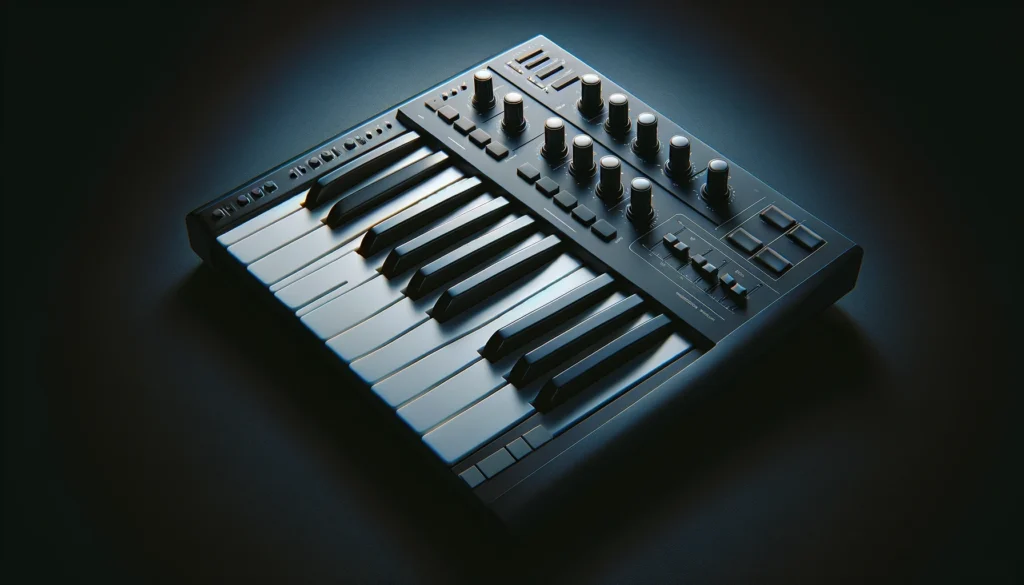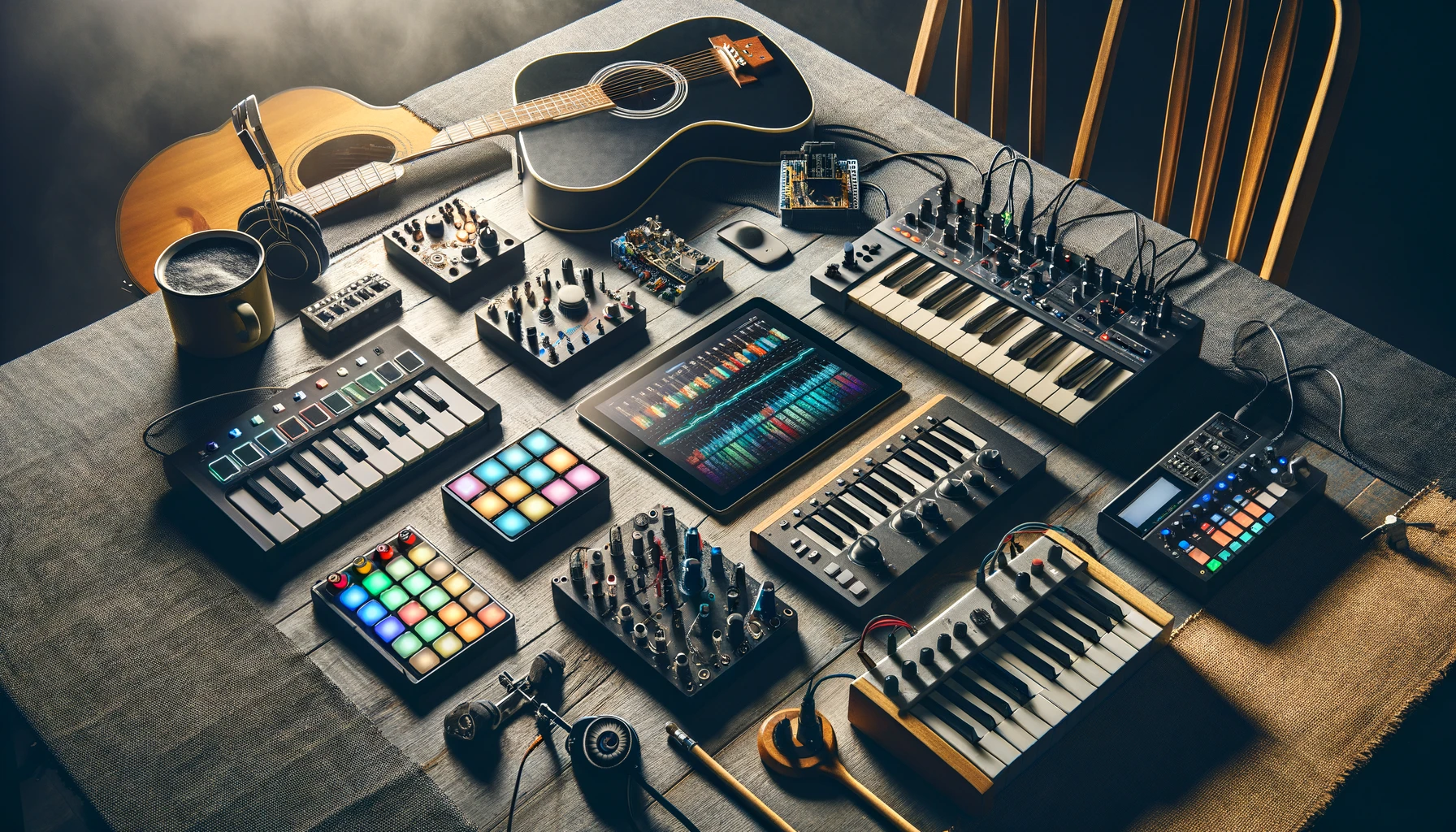Have you found yourself limited by the keys, pads and faders on your MIDI keyboard controller?
There’s a universe of alternative hardware and software opening up expressive new dimensions of MIDI sound manipulation.
We’ll survey fresh options beyond traditional keyboard controllers—from motion tracking devices to DIY Arduino boards—that give creators customizable interfaces tailored to their music workflow.
Let’s dive in to the innovations expanding MIDI creative possibilities.
What Are the Main Alternatives for MIDI Controllers?

The primary options beyond standard MIDI keyboard controllers include tablet/phone app controllers, MIDI guitar systems, drum pad triggers, motion tracking devices and DIY solutions using programmable boards.
As we explore below, these give musicians more ways to shape MIDI instruments and audio production software.
Traditional MIDI Keyboard Controllers

Digital pianos with MIDI connectivity allow you to use the keyboard and onboard sounds while also controlling external MIDI devices.
Options range from portable keyboards to high-end stage pianos with weighted keys and multiple sound engines.
Leading digital piano brands like Roland, Yamaha, Korg and Nord offer MIDI connectivity on most models.
When shopping, look for the number of keys, key feel action, onboard sounds, and MIDI in/out ports.
Keyboard synthesizers from companies like Moog, Dave Smith Instruments and Korg have MIDI implementation to interface with other MIDI gear.
Consider the number of keys, polyphony, built-in sounds, and flexibility of MIDI control when evaluating keyboard synthesizers.
MIDI capabilities should include MIDI in/out ports at minimum, with additional transport and sync options on more advanced models.
Dedicated MIDI keyboard controllers offer comprehensive control of external sound sources like virtual instruments and hardware synthesizers.
Leading options from Native Instruments, Arturia and other brands include drum pads, navigation controls, parameter knobs and faders.
The number of keys, velocity and aftertouch response, DAW/software integration and form factor are all important considerations.
Alternative Hardware Controllers

Tablet/Phone Apps
Touchscreen apps like TouchDAW and Lemur turn your phone or tablet into a customizable wireless MIDI and DAW controller.
Layouts can be designed with faders, knobs, keys and pads mapped to MIDI CCs and program parameters.
TouchOSC and MIDI Designer also allow wireless control of synthesizers and plugins.
Benefits include affordability, customization and wireless operation.
Drawbacks are smaller surfaces than hardware options and setup complexity.
Guitar/Bass MIDI Controllers
Special pickups and bridge assemblies enable MIDI conversion from guitar and bass playing.
Devices like the Roland GK-3 Divided Pickup and Fishman TriplePlay turn the guitar signal into MIDI data to drive synths and DAW software.
This allows extensive manipulation of synth tones using standard guitar playing techniques.
Brands include Roland, Fishman, Jam Origin, GThenv and more.
Consider tracking technology, latency and software integration.
Drum Pads/Triggers
Turning acoustic drums into a MIDI input device, drum trigger pads and acoustic drum triggers convert strikes into MIDI notes and controller data.
Roland, Yamaha, Alesis and other brands offer trigger interfaces and compatible electronic drum pads.
This allows drummers to trigger sounds in plugins, modules and synthesizers while maintaining an acoustic drum kit workflow.
Key aspects are responsiveness, crosstalk rejection and connectivity.
Motion Controllers
Novel MIDI controllers based on hand movements and gestures provide new ways to manipulate sound.
The Leap Motion Controller tracks individual finger movements which can shape synth parameters and effects.
Roli’s Seaboard Block is a pressure and glide sensing MIDI controller.
These motion-based controllers offer innovative options for dynamic MIDI expression and creation tools.
Look for accuracy of tracking, control resolution and ergonomic factors.
DIY/Modular Options
For customization or niche needs, developers and musicians build their own MIDI control devices using Arduino and Raspberry Pi boards programmed for MIDI I/O control.
Companies like Livid Instruments offer modular component blocks to construct personalized MIDI controllers.
If you have the technical skills, DIY solutions allow designing controllers tailored to your specific music workflow.
Consider connectivity, programming requirements and construction skills needed.
Key Considerations in Choosing Midi Controller Alternatives

When evaluating the range of MIDI controller alternatives, there are several key factors to weigh based on your needs and setup:
Connectivity is crucial – at minimum you’ll need MIDI input/output via 5-pin DIN ports, USB or possibly Bluetooth LE for wireless operation.
Check compatibility with your DAW, laptop ports and MIDI interface hardware.
Consider which operating systems are supported – Windows, Mac, iOS, Android etc.
Some controllers are platform exclusive while many support several OSes.
The types and number of controls will determine how deeply you can manipulate parameters for synths, virtual instruments and DAW functions.
More faders, knobs, pads equal finer degrees of real-time MIDI expression.
Ergonomics and workflow integration are important – you want controls mapped logically and accessible comfortably to your hand movements without excessive reach.
Well-designed controllers feel like natural extensions of music creation software.
Pricing ranges widely – from under $100 for DIY builds and used older MIDI keyboards to $500+ for latest feature-packed controllers from leading brands, factor in your budget constraints.
Conclusion
As this tour of MIDI controller alternatives shows, new interface paradigms keep emerging to provide producers personalized tools tailored to their creative workflow.
Whether you choose a software control app, pressure sensing instrumentation or DIY microcontroller solution, prioritize connectivity, compatibility and immediately accessible parameters tuned to your production style.
The world of MIDI isn’t confined to traditional keyboards and pads—follow these breakthrough technologies toward interfaces that feel imaginatively designed just for you.
